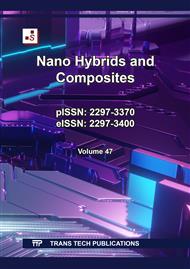[1]
Mohammad Raquibul Hasan1, Ian J. Davies2, Alokesh Pramanik2, Michele John1, Wahidul K. Biswas1, Impact of process parameters on improving the performance of 3D printed recycled polylactic acid (rPLA) components, The International.J. of Advanced Manufacturing Technology (2024) 131:3751–3779
DOI: 10.1007/s00170-024-13140-7
Google Scholar
[2]
Meltem Eryildiz, Effect of Build Orientation on Mechanical Behaviour and Build Time of FDM 3D-Printed PLA Parts: An Experimental Investigation, European Mechanical Science.J. (2021), 5(3): 116-120. doi: https://doi.org/10.26701/ems. 881254
DOI: 10.26701/ems.881254
Google Scholar
[3]
Mostafa Adel Hamed1*, Tahseen Fadhil Abbas1, The Impact of FDM Process Parameters on the Compression Strength of 3D Printed PLA Filaments for Dental Applications, Advances in Science and Technology Research Journal 2023, 17(4), 121–129
DOI: 10.12913/22998624/169468
Google Scholar
[4]
Luyao Gao, Aleksey D. Drozdov, The Use of Various Measurement Methods for Estimating the Fracture Energy of PLA (Polylactic Acid), Materials 2022, 15, 8623.
DOI: 10.3390/ma15238623
Google Scholar
[5]
Gökhan Bürge, Ersin Aytaç, Ali Evcil, Mahmut A. Sava, An Investigation on Mechanical Properties of PLA Produced by 3D Printing as an Implant Material, 978-1-7281-9090-7/20/$31.00 ©2020 IEEE
Google Scholar
[6]
Ramiro Mantecón, Miguel Marco, Ana Muñoz-Sanchez , George Youssef , José Díaz-Álvarez, Henar Miguélez, Additive Manufacturing and Mechanical Characterization of PLA-Based Skull Surrogates, Polymers 2023, 15, 58
DOI: 10.3390/polym15010058
Google Scholar
[7]
M Rismalia, S C Hidajat, I G R Permana, B Hadisujoto, M Muslimin, F Triawan, Infill pattern and density effects on the tensile properties of 3D printed PLA material, Journal of Physics, 1402 (2019) 044041
DOI: 10.1088/1742-6596/1402/4/044041
Google Scholar
[8]
Yanping Liu, DDS,a Wei Bai, MS,b Xian Cheng, DDS,c Jiehua Tian, DDS,d Donghao Wei, DDS, e Yuchun Sun, PhD, f Ping Di, MDg, Effects of printing layer thickness on mechanical properties of 3D-printed custom trays, J Prosthet Dent 2020
DOI: 10.1016/j.prosdent.2020.08.025
Google Scholar
[9]
Jayakumar N*, Senthilkumar G, Pradeep A D, Effect of Printing Parameters of 3D Printed PLA Parts on Mechanical Properties, Journal of Engg
DOI: 10.36909/jer.ICMMM.15697
Google Scholar
[10]
DP Putra1, Romli2, Akbar Teguh Prakoso1, NY Mahendra1, Muhammad Imam Ammarullah5, Muhammad Yanis1, Hendri Chandra1, Ardiyansyah Syahrom3, 4, Jamari5 and Hasan Basri1, Effect of 3D Printing Process Parameters on Flexural Strength of Mixing PLA and PCL Polymer, AIP Conf. Proc. 2689, 070002-1–070002-6
DOI: 10.1063/5.0116239
Google Scholar
[11]
J. Antonio Travieso-Rodriguez 1,* , Ramon Jerez-Mesa 2 , Jordi Llumà 3 , Oriol Traver-Ramos 1, Giovanni Gomez-Gras 4 and Joan Josep Roa Rovira 3, Mechanical Properties of 3D-Printing Polylactic Acid Parts subjected to Bending Stress and Fatigue Testing, Materials 2019, 12, 3859
DOI: 10.3390/ma12233859
Google Scholar
[12]
Tedy Apriawan1,2*, Khrisna Rangga Permana1,2, Ditto Darlan1,2, Muhammad Reza Arifianto1,2, Fitra Fitra1,2, Asra Alfauzi1,2, Abdul Hafid Bajamal1,2, Polylactic Acid Implant for Cranioplasty with 3-dimensional Printing Customization: A Case Report, Open Access Macedonian Journal of Medical Sciences (2020) Nov 10; 8(C):151-155
DOI: 10.3889/oamjms.2020.5156
Google Scholar
[13]
Muammel M. Hanona,b,, József Dobosa, László Zsidaia, The influence of 3D printing process parameters on the mechanical performance of PLA polymer and its correlation with hardness, Procedia Manufacturing 54 (2021) 244–249.
DOI: 10.1016/j.promfg.2021.07.038
Google Scholar
[14]
Ali Akbar Yousefi and Dariush Ebrahimibagha, Effects of processing conditions on mechanical properties of PLA printed parts, Rapid Prototyping Journal (2019) 381–389, [.
DOI: 10.1108/rpj-02-2019-0048
Google Scholar
[15]
Sunpreet Singh, Gurminder Singh, Chander Prakash, Seeram Ramakrishna,Luciano Lamberti and Catalin I. Pruncu, 3D printed biodegradable composites: an insight into mechanical properties of PLA/chitosan scaffold, Pre-proof Journal (2020).
DOI: 10.1016/j.polymertesting.2020.106722
Google Scholar
[16]
Cosmin-Florin Popaa, Mihai-Petru Mărghitașa, Sergiu-Valentin Galațanua*, Liviu Marșavinaa, Influence of thickness on the IZOD impact strength of FDM printed specimens from PLA and PETG, Procedia Structural Integrity (2022) 557–563.
DOI: 10.1016/j.prostr.2022.05.064
Google Scholar


